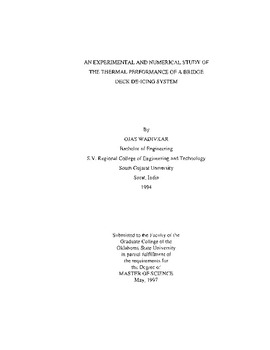| dc.contributor.author | Wadivkar, Ojas | |
| dc.date.accessioned | 2014-09-29T19:41:41Z | |
| dc.date.available | 2014-09-29T19:41:41Z | |
| dc.date.issued | 1997-05-01 | |
| dc.identifier.uri | https://hdl.handle.net/11244/12410 | |
| dc.description.abstract | Snow, sleet and freezing rain can cause hazardous conditions for unsuspecting or inattentive motorists. Loss of control of the vehicle because of the slick road may lead to dangerous accidents. The formation of ice or frost on bridge decks, while the other part of the road remains ice free is a well known phenomenon and is called preferential icing. Numerous accidents result every year during the winter season due to this. This has led to many countermeasures being developed and new methods being researched at many locations. In a study done in the late 70's, it was estimated that 25,000 accidents occurred annually in the United States alone, due to ice and frost on bridge decks (Blackburn et aI., 1978). It is therefore extremely important to prevent this preferential icing effect. In the past various strategies have been employed. The responses may range from using deicing agents or embedded heating elements to high intensity infra red heaters. Some of these methods are in use universally while others have only been tested at certain locations. | |
| dc.format | application/pdf | |
| dc.language | en_US | |
| dc.publisher | Oklahoma State University | |
| dc.rights | Copyright is held by the author who has granted the Oklahoma State University Library the non-exclusive right to share this material in its institutional repository. Contact Digital Library Services at lib-dls@okstate.edu or 405-744-9161 for the permission policy on the use, reproduction or distribution of this material. | |
| dc.title | Experlmental and Numerical Study of the Thermal Performance of a Bridge Deck De-icing System | |
| dc.type | text | |
| osu.filename | Thesis-1997-W122e-1.pdf | |
| osu.accesstype | Open Access | |
| dc.type.genre | Thesis | |
